肯定句变否定句
- 格式:doc
- 大小:40.00 KB
- 文档页数:2

一、首先,要看肯定句中是否有情态动词,如果有情态动词,直接在情态动词后面加not即可,同时句中如果有some,some就要变成any。
举例如下:1、肯定句:Mike can help you solve the problem.译文:迈克可以帮你解决那个问题。
否定句:Mike can't help you solve the problem. (can't=can not)译文:迈克不能帮你解决那个问题。
2、肯定句:You should lend some money to Mary.译文:你应该借给玛丽一些钱。
否定句:You shouldn't lend any money to Mary. (shouldn't=should not)译文:你不应该借钱给玛丽。
二、如果肯定句中没有情态动词,那就要看句中有无be动词的相应形式,如果有,直接在be动词后面加not,句中有some,some变any。
举例如下:1、肯定句:I am an English teacher.译文:我是一名英语老师。
否定句:I‘m not an English teacher.译文:我不是一名英语老师。
2、肯定句:There are some books on the desk.译文:书桌上有一些书。
否定句:There aren't any books on the desk.译文:书桌上没有书。
三、如果肯定句中既没有情态动词,也没有be动词,那么就要用相应的助动词加上not来变换,句中有some,some变any。
举例如下:1、肯定句:She likes helping others.译文:她喜欢帮助别人。
否定句:She doesn't like helping others.译文:她不喜欢帮助别人。
2、肯定句:They have some apples.译文:他们有一些苹果。
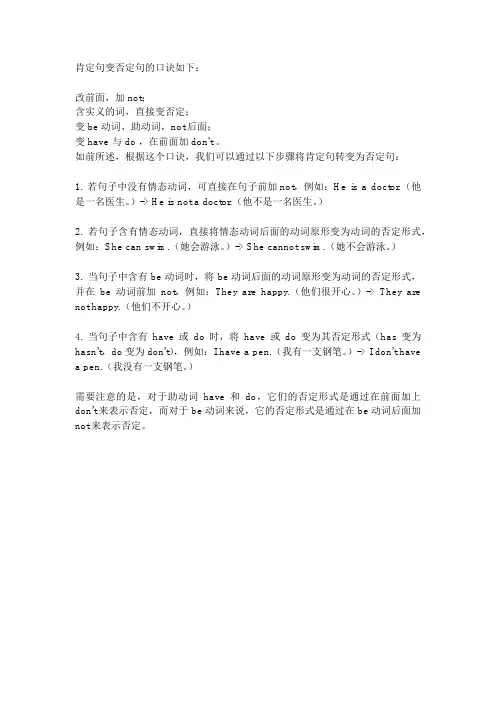
肯定句变否定句的口诀如下:
改前面,加not;
含实义的词,直接变否定;
变be动词、助动词,not后面;
变have 与 do ,在前面加don't 。
如前所述,根据这个口诀,我们可以通过以下步骤将肯定句转变为否定句:
1. 若句子中没有情态动词,可直接在句子前加not,例如:He is a doctor.(他是一名医生。
)-> He is not a doctor.(他不是一名医生。
)
2. 若句子含有情态动词,直接将情态动词后面的动词原形变为动词的否定形式,例如:She can swim.(她会游泳。
)-> She cannot swim.(她不会游泳。
)
3. 当句子中含有be动词时,将be动词后面的动词原形变为动词的否定形式,并在be动词前加not,例如:They are happy.(他们很开心。
)-> They are not happy.(他们不开心。
)
4. 当句子中含有have或do时,将have或do变为其否定形式(has变为hasn't,do变为don't),例如:I have a pen.(我有一支钢笔。
)-> I don't have a pen.(我没有一支钢笔。
)
需要注意的是,对于助动词have和do,它们的否定形式是通过在前面加上don't来表示否定,而对于be动词来说,它的否定形式是通过在be动词后面加not来表示否定。
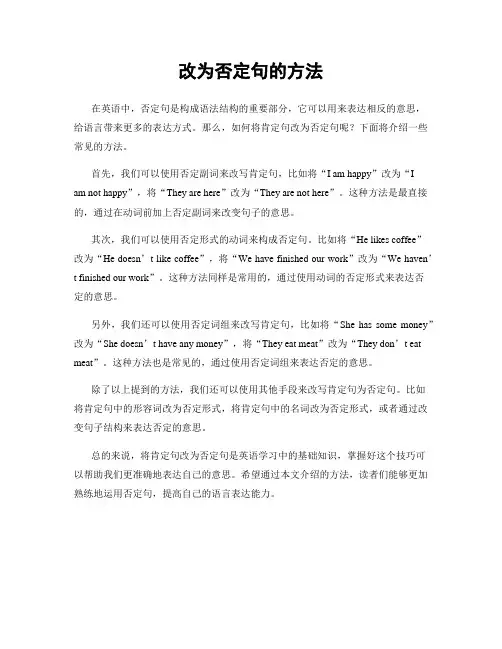
改为否定句的方法
在英语中,否定句是构成语法结构的重要部分,它可以用来表达相反的意思,
给语言带来更多的表达方式。
那么,如何将肯定句改为否定句呢?下面将介绍一些常见的方法。
首先,我们可以使用否定副词来改写肯定句,比如将“I am happy”改为“I
am not happy”,将“They are here”改为“They are not here”。
这种方法是最直接的,通过在动词前加上否定副词来改变句子的意思。
其次,我们可以使用否定形式的动词来构成否定句。
比如将“He likes coffee”
改为“He doesn’t like coffee”,将“We have finished our work”改为“We haven’t finished our work”。
这种方法同样是常用的,通过使用动词的否定形式来表达否
定的意思。
另外,我们还可以使用否定词组来改写肯定句,比如将“She has some money”改为“She doesn’t have any money”,将“They eat meat”改为“They don’t eat meat”。
这种方法也是常见的,通过使用否定词组来表达否定的意思。
除了以上提到的方法,我们还可以使用其他手段来改写肯定句为否定句。
比如
将肯定句中的形容词改为否定形式,将肯定句中的名词改为否定形式,或者通过改变句子结构来表达否定的意思。
总的来说,将肯定句改为否定句是英语学习中的基础知识,掌握好这个技巧可
以帮助我们更准确地表达自己的意思。
希望通过本文介绍的方法,读者们能够更加熟练地运用否定句,提高自己的语言表达能力。

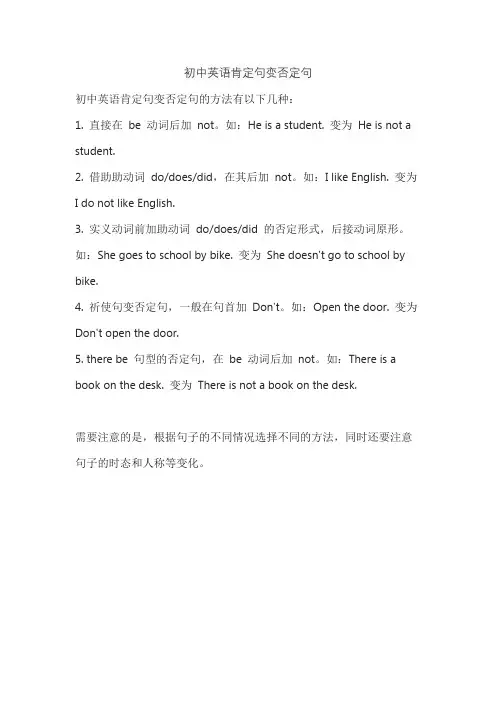
初中英语肯定句变否定句
初中英语肯定句变否定句的方法有以下几种:
1. 直接在be 动词后加not。
如:He is a student. 变为He is not a student.
2. 借助助动词do/does/did,在其后加not。
如:I like English. 变为
I do not like English.
3. 实义动词前加助动词do/does/did 的否定形式,后接动词原形。
如:She goes to school by bike. 变为She doesn't go to school by bike.
4. 祈使句变否定句,一般在句首加Don't。
如:Open the door. 变为Don't open the door.
5. there be 句型的否定句,在be 动词后加not。
如:There is a book on the desk. 变为There is not a book on the desk.
需要注意的是,根据句子的不同情况选择不同的方法,同时还要注意句子的时态和人称等变化。

肯定句变否定句的基本方法一、动词be 的否定式动词be根据不同的人称和时态可以有am, is, are, was, were等不同形式,可用作连系动词(表示“是”、“在”等)和助动词(用于构成进行时态和被动语态等),但不管何种情况,构成否定式时,一律在其后加notI’m old, but you’re young. 我老了,但你还年轻。
→I’m not old, but you’re not young. 我还不老,但你不年轻了。
He was reading and I was writing. 他在读,我在写。
→He was not reading and I was not writing. 他没有在读,我没有在写。
二、动词have 的否定式动词have根据不同的人称和时态可以有have, has, had等形式,可以用作实意动词和助动词,分以下情况讨论1. 用作实意动词表示状态,如表示拥有、患病或用于have to表示“必须”等,在构成否定式时可以直接在其后加not,也可根据情况在其前使用don’t, doesn’t, didn’tHe has a car. 他有辆小汽车。
→He hasn’t a car. / He doesn’t have a car. 他没有小汽车。
He had some dictionaries. 他有一些词典。
→He hadn’t any dictionaries. / He didn’t have any dictionaries. 他没有词典。
You have to go with him. 你必须同他一起去。
→You haven’t to go with him. / You don’t have to go w ith him. 你不必同他一起去。
【注】have to构成否定式时以在其前加don’t等较为常见。
2. 用作实意动词表示动作,如表示“吃(=eat)”、“喝(=drink)”、“拿(=take)”、“收到(=receive)”、“度过(=spend)”等,构成否定式时不能直接在其后加not,而应根据情况在其前使用don’t, doesn’t, didn’tHe had some cake for breakfast. 他早餐吃了些蛋糕。
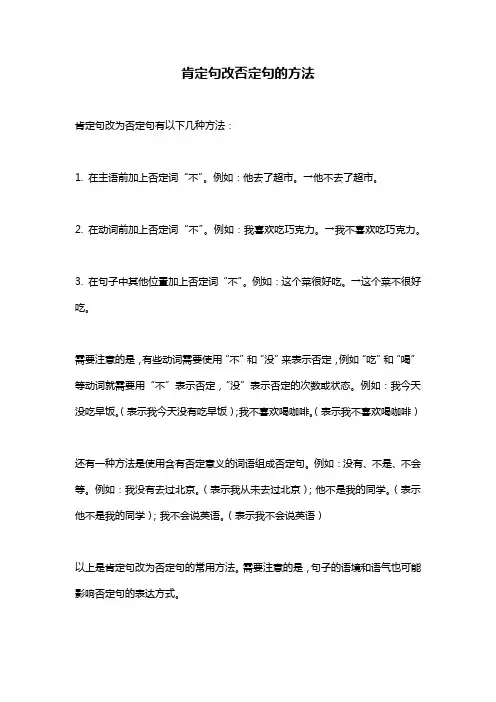
肯定句改否定句的方法
肯定句改为否定句有以下几种方法:
1. 在主语前加上否定词“不”。
例如:他去了超市。
→他不去了超市。
2. 在动词前加上否定词“不”。
例如:我喜欢吃巧克力。
→我不喜欢吃巧克力。
3. 在句子中其他位置加上否定词“不”。
例如:这个菜很好吃。
→这个菜不很好吃。
需要注意的是,有些动词需要使用“不”和“没”来表示否定,例如“吃”和“喝”等动词就需要用“不”表示否定,“没”表示否定的次数或状态。
例如:我今天没吃早饭。
(表示我今天没有吃早饭);我不喜欢喝咖啡。
(表示我不喜欢喝咖啡)
还有一种方法是使用含有否定意义的词语组成否定句。
例如:没有、不是、不会等。
例如:我没有去过北京。
(表示我从未去过北京);他不是我的同学。
(表示他不是我的同学);我不会说英语。
(表示我不会说英语)
以上是肯定句改为否定句的常用方法。
需要注意的是,句子的语境和语气也可能影响否定句的表达方式。
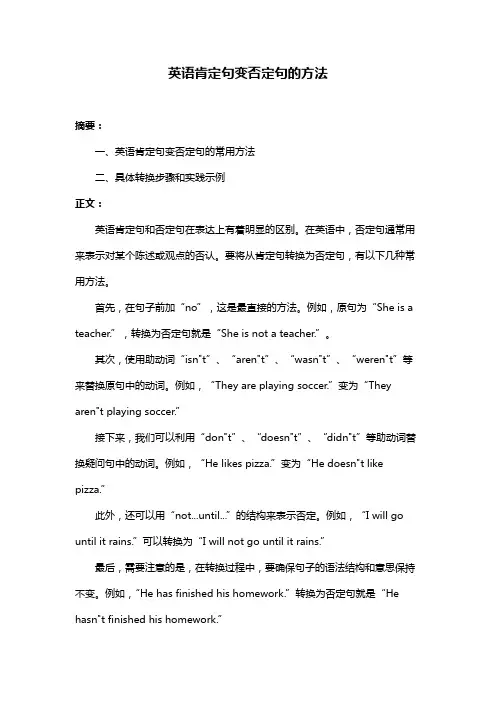
英语肯定句变否定句的方法摘要:一、英语肯定句变否定句的常用方法二、具体转换步骤和实践示例正文:英语肯定句和否定句在表达上有着明显的区别。
在英语中,否定句通常用来表示对某个陈述或观点的否认。
要将从肯定句转换为否定句,有以下几种常用方法。
首先,在句子前加“no”,这是最直接的方法。
例如,原句为“She is a teacher.”,转换为否定句就是“She is not a teacher.”。
其次,使用助动词“isn"t”、“aren"t”、“wasn"t”、“weren"t”等来替换原句中的动词。
例如,“They are playing soccer.”变为“They aren"t playing soccer.”接下来,我们可以利用“don"t”、“doesn"t”、“didn"t”等助动词替换疑问句中的动词。
例如,“He likes pizza.”变为“He doesn"t like pizza.”此外,还可以用“not...until...”的结构来表示否定。
例如,“I will go until it rains.”可以转换为“I will not go until it rains.”最后,需要注意的是,在转换过程中,要确保句子的语法结构和意思保持不变。
例如,“He has finished his homework.”转换为否定句就是“He hasn"t finished his homework.”总之,掌握以上方法,就可以轻松地将英语肯定句转换为否定句。
在实际应用中,根据不同的语境和句子结构,选择合适的方法进行转换,使句子更加丰富和生动。
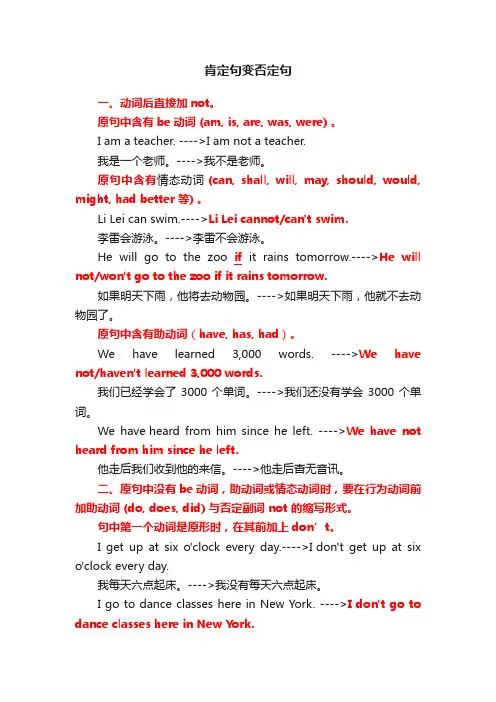
肯定句变否定句一、动词后直接加not。
原句中含有be动词 (am, is, are, was, were) 。
I am a teacher. ---->I am not a teacher.我是一个老师。
---->我不是老师。
原句中含有情态动词 (can, shall, will, may, should, would, might, had better 等) 。
Li Lei can swim.---->Li Lei cannot/can't swim.李雷会游泳。
---->李雷不会游泳。
He will go to the zoo if it rains tomorrow.---->He will not/won't go to the zoo if it rains tomorrow.如果明天下雨,他将去动物园。
---->如果明天下雨,他就不去动物园了。
原句中含有助动词(have, has, had)。
We have learned 3,000 words. ---->We have not/haven't learned 3,000 words.我们已经学会了3000个单词。
---->我们还没有学会3000个单词。
We have heard from him since he left. ---->We have not heard from him since he left.他走后我们收到他的来信。
---->他走后杳无音讯。
二、原句中没有be动词,助动词或情态动词时,要在行为动词前加助动词 (do, does, did) 与否定副词 not 的缩写形式。
句中第一个动词是原形时,在其前加上don’t。
I get up at six o'clock every day.---->I don't get up at six o'clock every day.我每天六点起床。
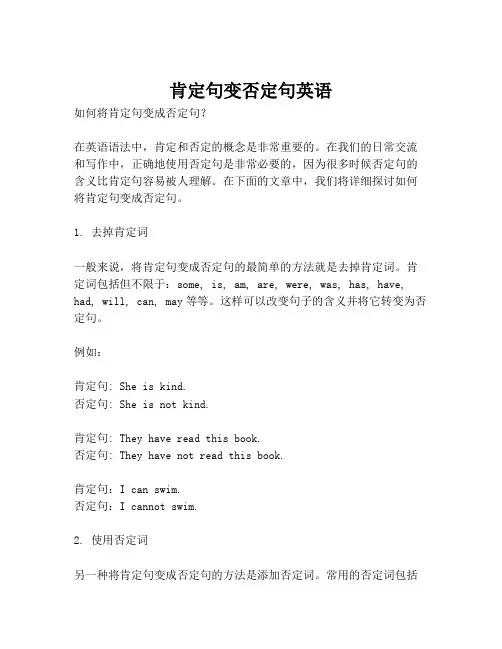
肯定句变否定句英语如何将肯定句变成否定句?在英语语法中,肯定和否定的概念是非常重要的。
在我们的日常交流和写作中,正确地使用否定句是非常必要的,因为很多时候否定句的含义比肯定句容易被人理解。
在下面的文章中,我们将详细探讨如何将肯定句变成否定句。
1. 去掉肯定词一般来说,将肯定句变成否定句的最简单的方法就是去掉肯定词。
肯定词包括但不限于:some, is, am, are, were, was, has, have, had, will, can, may等等。
这样可以改变句子的含义并将它转变为否定句。
例如:肯定句: She is kind.否定句: She is not kind.肯定句: They have read this book.否定句: They have not read this book.肯定句:I can swim.否定句:I cannot swim.2. 使用否定词另一种将肯定句变成否定句的方法是添加否定词。
常用的否定词包括但不限于:no, not, never, nothing, neither等等。
使用这些否定词能给句子带来否定的意义。
例如:肯定句: He asked me something.否定句: He didn’t ask me anything.肯定句: He always comes late.否定句: He never comes early.肯定句: I like coffee.否定句: I don’t like coffee.3. 使用相反的形容词或副词在有些情况下,我们可以使用相反的形容词或副词来将肯定句变成否定句。
例如,将“happy”换成“unhappy”,将“fast”换成“slow”等等。
例如:肯定句:She is beautiful.否定句:She is not ugly.肯定句:He is tall.否定句:He is not short.肯定句:He runs fast.否定句:He does not run slowly.总之,在英语语法中,正确使用肯定句和否定句非常重要。
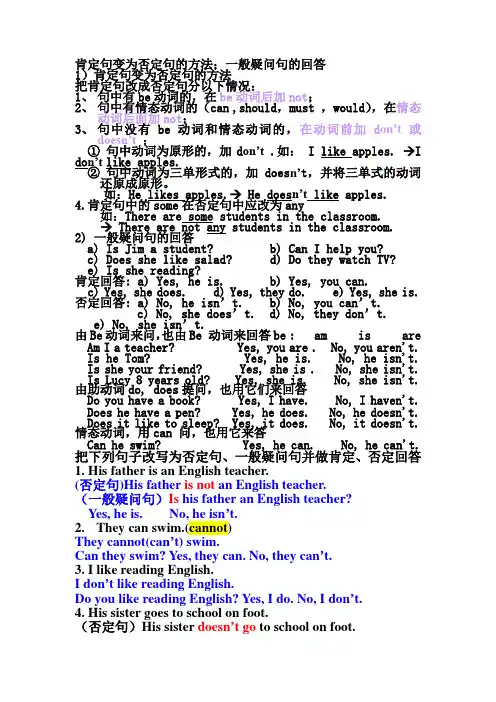
肯定句变为否定句的方法;一般疑问句的回答1)肯定句变为否定句的方法把肯定句改成否定句分以下情况:1、句中有be动词的,在be动词后加not;2、句中有情态动词的(can ,should,must ,would),在情态动词后面加not;3、句中没有be动词和情态动词的,在动词前加d on’t或doesn’t;①句中动词为原形的,加d on’t.如: I like apples. →Ido n’t like apples.②句中动词为三单形式的,加does n’t,并将三单式的动词还原成原形。
如:He likes apples.→ He does n’t like apples.4.肯定句中的some在否定句中应改为any如:There are some students in the classroom.→ There are not any students in the classroom.2) 一般疑问句的回答a) Is Jim a student? b) Can I help you?c) Does she like salad? d) Do they watch TV?e) Is she reading?肯定回答: a) Yes, he is. b) Yes, you can.c) Yes, she does. d) Yes, they do. e) Yes, she is.否定回答: a) No, he isn’t. b) No, you can’t.c) No, she does’t. d) No, they don’t.e) No, she isn’t.由Be动词来问,也由Be 动词来回答be : am is areAm I a teacher? Yes, you are . No, you aren't.Is he Tom? Yes, he is. No, he isn't.Is she your friend? Yes, she is . No, she isn't.Is Lucy 8 years old? Yes, she is. No, she isn't.由助动词do, does提问,也用它们来回答Do you have a book? Yes, I have. No, I haven't. Does he have a pen? Yes, he does. No, he doesn't. Does it like to sleep? Yes, it does. No, it doesn't.情态动词,用can 问,也用它来答Can he swim? Yes, he can. No, he can't. 把下列句子改写为否定句、一般疑问句并做肯定、否定回答1. His father is an English teacher.(否定句)His father is not an English teacher.(一般疑问句)Is his father an English teacher?Yes, he is. No, he isn’t.2. They can swim.(cannot)They cannot(can’t) swim.Can they swim? Yes, they can. No, they can’t.3. I like reading English.I don’t like reading English.Do you like reading English? Yes, I do. No, I don’t.4. His sister goes to school on foot.(否定句)His sister doesn’t go to school on foot.(一般疑问句)Does his sister go to school on foot? Yes, she does. No, she doesn’t.5. Mrs Li and Kitty watch TV at night.Mrs Li and Kitty don’t watch TV at night.Do Mrs Li and Kitty watch TV at night?Yes, they do. No, they don’t.6. I do my homework after school.I don’t do my homework after school.Do you do your homework after school?Yes, I do. No, I don’t.课后练习把下列句子改写为否定句、一般疑问句及肯定、否定回答1. The boy does some housework at home.2. We are from China.3. Jim has some books.4. I have a football book.5. My aunt often watches TV.6. My parents can play ping-pong.7. They are my grandparents.8. Gina wants a cup of coffeeAre you a student? Are you students? Does he look cool?Can she draw? Can they dance?。
1.有be动词或者情态动词的肯定句变否定句转变方法:在be动词或情态动词后面直接加not例1. I am a student. → I am not a student.例2. You are sad. → You are not sad.例3. I can swim. → I can not swim.例4. You will go to the park.→ You will not go to the park.2.没有be动词也没有情态动词,有实意动词(表示动作的动词)的肯定句变否定句转变方法:借助助动词(do, does, did)来帮助否定①当句中的动词是原形时,加don't。
例1. I like English.→ I do not like English.例2. You have dinner.→ You do not have dinner.②当句中的动词是第三人称单数时,加doesn't ,再加动词原形。
例1. She likes singing.→She doesn't like singing.例2. She does her homework.→ She does not do her homework.③当句中的动词是过去式时,用didn't,加动词原形例: We had a great time during our holidays.→We did not have a great time during our holidays.3. 动词have/has的特殊说明:①当have表示“某人有什么的时候”,其否定形式为have not/has not例: She has two books.→ She has not two books.②当have作为实意动词时,其否定形式为do not have/does not have例: You have dinner.→You do not have dinner.③当have在完成时中作为助动词时,其否定形式为have not/has not例: I have seen this film.→ I have not seen this film.4. 一些特殊说明:①肯定陈述句中的some/too,在否定陈述句中应改为any/either。
1、You can use this dictionary.(改为否定句)You cannot(can’t)use this dictionary.2、There is some wonderful news in today’s paper.(改为否定句)There are any wonderful news in today’s paper.3、They play football on the playground.(改为一般疑问句,并作肯定回答)Do they play football on the playground?Yes, they do.4、This is my ID card.(改为一般疑问句)Is this your ID card?5、The schoolbag is under the desk.(改为一般疑问句,并作肯定回答)Is the schoolbag under the desk?Yes,it is.一、肯定句改否定句的方法:1、在be动词后加not。
如:is not ,are not ,am not,was not,were not;2、在can,should,will等后加not。
如:cannot,should not,will not;3、上述都没有的,在动词前加助动词否定形式don’t/doesn’t/didn’t。
4、some 改成any。
如:I am a girl. →I am not a girl.You are a student. →You are not a student.→You aren’t a student.This is Tom’s bag, →This is not Tom’s bag.→This isn’t Tom’s bag.答题方法是;否定词no t在be后边。
二、肯定句改一般疑问句的方法:1、把be动词放在句首,剩下的照抄,(some 改成any,I改成you,my改成your,)句点改成问号。
英语肯定句改为否定句口诀
以下是一些常见的英语肯定句改为否定句的口诀,帮助您快速掌握。
1.一般现在时
-肯定句:主语+动词原形
-否定句:主语+do/does not+动词原形
2.一般过去时
-肯定句:主语+动词过去式
-否定句:主语+did not+动词原形
3.一般将来时
-肯定句:主语+will+动词原形
-否定句:主语+will not/won't+动词原形
4.现在进行时
-肯定句:主语+am/is/are+动词-ing形式
-否定句:主语+am/is/are not+动词-ing形式
5.现在完成时
-肯定句:主语+have/has+过去分词
-否定句:主语+have/has not+过去分词
6.过去进行时
-肯定句:主语+was/were+动词-ing形式
-否定句:主语+was/were not+动词-ing形式
7.过去完成时
-肯定句:主语+had+过去分词
-否定句:主语+had not+过去分词
8.情态动词
-肯定句:主语+情态动词+动词原形
-否定句:主语+情态动词+not+动词原形
9.be动词(一般现在时)
-肯定句:主语+am/is/are
-否定句:主语+am/is/are not
10.be动词(一般过去时)
-肯定句:主语+was/were
-否定句:主语+was/were not
这些口诀可以帮助您快速记住肯定句改为否定句的基本规则。
然而,需要注意的是,有些特殊情况下,否定形式可能会有其他变化或使用不同的词汇。
因此,在具体应用时,仍需结合具体语境和语法规则进行判断和运用。
一、简单句中含有be动词、情态动词和助动词时,变否定句时需在be动词、情态动词和助动词后加not。
1. (am, is ,are 是be动词)如:I am a teacher.→I am nota teacher.This is a pen.→ This is not a pen.或This isn’t a pen. (is not =isn’t) You are a boy. →You are not a boy. (are not =aren’t)2. (can是情态动词)He can help me.→He can not help me.或He can’t help me.(can not =can’t )3.当主语是第一人称、第二人称和第三人称复数时用助动词do,变否定时,在do后面加not 如:I like English .I do not like English.或I don’t like English.They go to school together. →They do not (don’t) go to school together.4.当主语是第三人称单数时用does,变否定时,在does后面加not,如:The little girl wants to go there.→ The little girl does not (doesn't ) want to go there.2.简单句中谓语动词为行为动词时,要根据时态选用do的相应形式,把肯定句变为否定句。
如:The little girl wants to go there.→The little girl doesn't want to go there.He did his work yesterday.→He didn't do his work yesterday.3.祈使句变否定句时,一般在句首加Don't,但Let us或Let's 开头的祈使句在Let us或Let's后加not也可。
简单肯定句变否定句
简单肯定句指的是陈述一个事实或情况的句子,而简单否定句则是指否定这个事实或情况的句子。
下面介绍一些常见的简单肯定句变否定句的方法:
1. 在动词前加上否定词not。
例如:He is happy.(他很高兴。
)→ He is not happy.(他不高兴。
)
2. 使用否定形式的动词。
例如:She doesn't like coffee.(她不喜欢咖啡。
)
3. 使用否定的副词或形容词来修饰动词或名词,例如:The weather is not good.(天气不好。
)→ He is not very tall.(他不是很高。
)
需要注意的是,一些特殊的动词和形容词在否定时会有不同的形式,例如:
1. be动词的否定形式是not be。
例如:I am not hungry.(我不饿。
)
2. have动词的否定形式是do not have或have not。
例如:She does not have a car.(她没有车。
)
3. can动词的否定形式是cannot或can't。
例如:I cannot swim.(我不会游泳。
)
4. some和any的否定形式是no和none。
例如:There is no milk in the fridge.(冰箱里没有牛奶。
)
总之,掌握简单肯定句变否定句的方法是英语学习中的基础,需
要多加练习和记忆。
一、简单句中含有be动词、情态动词和助动词时,变否定句时需在be动词、情态动词和助动词后加not。
1。
(am, is ,are 是be动词)如: I am a teacher.→I am not a teacher.This is a pen。
→ This is not a pen.或This isn't a pen。
(is not =isn’t)You are a boy. →You are not a boy. (are not =aren’t)2. (can是情态动词)He can help me.→He can not help me.或He can't help me。
(can not =can’t )3。
当主语是第一人称、第二人称和第三人称复数时用助动词do,变否定时,在do后面加not 如:I like English 。
I do not like English.或I don’t like English.They go to school together。
→They do not (don’t)go to school together。
4.当主语是第三人称单数时用does,变否定时,在does后面加not,如:The little girl wants to go there。
→ The little girl does not (doesn’t )want to go there.2.简单句中谓语动词为行为动词时,要根据时态选用do的相应形式,把肯定句变为否定句.如:The little girl wants to go there.→The little girl doesn't want to go there.He did his work yesterday.→He didn't do his work yesterday.3.祈使句变否定句时,一般在句首加Don't,但Let us或Let's 开头的祈使句在Let us或Let’s后加not也可。
例析肯定句变否定句
一、一、由添加not来完成的否定句
1、1、谓语动词由行为动词及其词组构成且不含有任何助动词的陈述句,应在
行为动词或词组前加do(does、did)not 来构成否定句。
You have to finish your homework now. 你现在必须完成你的作业。
You don’t have to finish your homework now. 你现在不必完成你的作业。
She likes rice and noodles for lunch 。
她午饭喜欢吃米饭和面条。
She doesn’t like rice and noodles for lunch 。
她午饭不喜欢吃米饭和面条。
We planted 100 trees yesterday afternoon。
我们昨天下午栽了100棵树。
We didn’t plant 100 trees yesterday afternoon。
我们昨天下午没有栽100棵树。
2、2、当句子的谓语动词含有情态动词、be动词、助动词have(has、had)、
would、will等动词时,应在这些动词之后加not来构成否定句。
He can speak Russian well。
他俄语讲的不错。
He can’t speak Russian well。
他俄语讲的不好。
They are 3—good students in this term 。
他们是本学期的三好学生。
They aren’t 3—good students in this term 。
他们不是本学期的三好学生。
The film had begun when he got to the cinema。
当他到达电影院时,电影早已开演了。
The film hadn’t begun when he got to the cinema。
当他到达电影院时,电影还没有开演。
He has been to the US. 他去过美国。
He hasn’t been to the US. 他没有去过美国。
They will have a meeting tomorrow。
他们准备明天开会。
They won’t have a meeting tomorrow。
他们明天不准备开会。
I would like to help you with your English 。
我愿意帮助你的英语。
I wouldn’t like to help you with your English 。
我不愿意帮助你的英语。
3、在复合句中,当主句动词含有hope、wish、I am afraid 等动词时,变否定句一般只否定从句;当主句动是think、believe、guess等动词时,变否定句只否定主句。
I hope he can pass the exam this time 。
我希望他这次考试能够及格。
I hope he can’t pass the exam this time 。
我希望他这次考试不及格。
He wishes he can make a lot of money this year 。
他希望今年能赚大钱。
He wishes he can’t make a lot of money this year 。
他希望今年赚不到钱。
I am afraid he is our new teacher 。
恐怕他是咱们的新老师。
I am afraid he isn’t our new teacher 。
恐怕他不是咱们的新老师。
I think he is a thief 。
我认为他是个小偷。
I don’t think he is a thief 。
我认为他不是个小偷。
I believe they are outstanding students 。
我相信他们是优秀生。
I don’t believe they are outstanding students 。
我相信他们不是优秀生。
4、将动词不定式变为否定形式时,只在动词不定式符号to 前加not即可;没有动词不定式符号to时,直接在动词前加not 。
The boss asked us to work twelve hours a day。
老板要我们每天工作12个小时。
The boss asked us not to work twelve hours a day。
老板要我们不要每天工作12个小时。
Why open the window ,Lao Wang ?老王,干嘛要打开窗子?
Why not open the window ,Lao Wang ?老王,干嘛不打开窗子?
You’d better have your hair cut now。
你最好现在去理发。
You’d better not have your hair cut now。
你最好现在别去理发。
二、二、不用not 来完成的否定句
1、1、everything 、something →nothing
Something is wrong with my radio 。
我的收音机出毛病了。
Nothing is wrong with my radio 。
我的收音机没毛病。
Everything goes well 。
一切进展顺利。
Nothing goes well 。
一切进展不顺利。
2、2、both ... and → neither ...nor
Both my father and mother are teachers。
我的父母都是教师。
Neither my father nor mother is a teacher 。
我的父母都不是教师。
3、3、always →never
Bob always has his breakfast at 7:30 。
鲍勃总是在七点半吃早饭。
Bob never has his breakfast at 7:30 。
鲍勃从不在七点半吃早饭。
4 all →none
All of the friends of mine graduated from college 。
我的朋友都是大学生。
None of the friends of mine graduated from college 。
我的朋友没有一个是大学生。
5、5、much →little
There is much time to finish your task 。
有充足的时间来完成你的任务。
There is little time to finish your task 。
几乎没有时间来完成你的任务。
6、many→few
I have many friends in the countryside 。
我有很多乡下的朋友。
I have few friends in the countryside 。
我几乎没有乡下的朋友。
7、almost→hardly
He can almost see the words on the blackboard 。
他几乎看清了所有黑板上的字。
He can hardly see the words on the blackboard 。
他几乎看不清黑板上的字。
8、often→seldom
The boy often goes to school by bike 。
这小男孩经常骑自行车上学。
The boy seldom goes to school by bike 。
这小男孩很少骑自行车上学。
9、somebody→nobody
Somebody called you yesterday 。
昨天有人给你打电话了。
Nobody called you yesterday 。
昨天没人给你打电话
10、so→ neither(nor)
He can finish his homework by himself ,so can I 。
他能独立完成作业,我也能。
He can’t finish his homework by himself ,neither can I 。
他不能独立完成作业,我也不能。